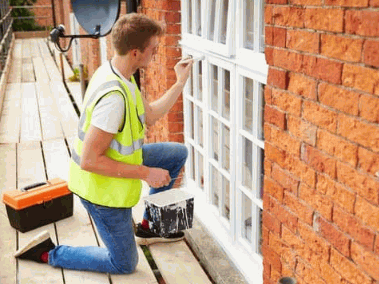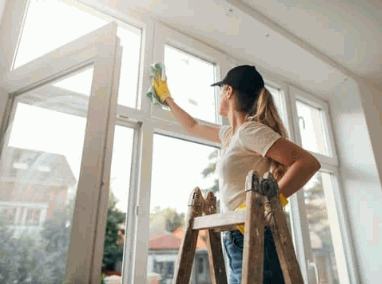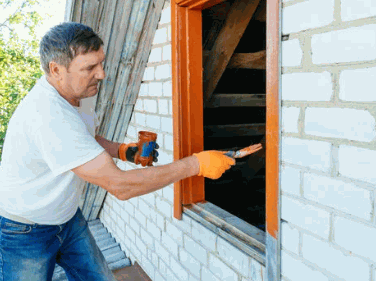Table of Contents
Are your UPVC windows appearing worn or outdated? Painting them can revitalize your home’s exterior, transforming its appearance without necessitating a complete replacement. This article will examine what UPVC windows are, outline the advantages of painting them, and provide a comprehensive step-by-step process for achieving a flawless finish. Additionally, it will discuss the most suitable types of paint and offer essential tips to ensure the success of your project. Prepare to enhance your living space effectively.

UPVC windows, or Unplasticized Polyvinyl Chloride windows, are a widely preferred option for homeowners seeking to enhance their properties. Renowned for their durability, energy efficiency, and minimal maintenance needs, these windows provide a sophisticated finish that can greatly contribute to home improvement initiatives.
They are offered in a variety of designs, including French doors and casement styles, allowing them to complement diverse architectural aesthetics.
Take a look: Can You Spray Paint Wooden Kitchen Cabinets
Painting UPVC windows can fulfill several objectives, including altering the color and revitalizing the appearance of a residence, thereby becoming a crucial aspect of home renovation and improvement initiatives.
By employing appropriate techniques and materials, homeowners can attain a high-quality finish that enhances the aesthetic appeal of their property. Whether selecting an elegant dark bronzey green or a more vibrant shade, painting UPVC can effectively rejuvenate window frames and sills.

Homeowners often choose to paint UPVC windows primarily to change the color and provide their properties with a fresh aesthetic upgrade. This undertaking can significantly alter the overall appearance of a home, making it more inviting and aligning it with individual style preferences.
By selecting a different color, the overall décor can be enhanced considerably, facilitating a cohesive theme throughout the property. For example, dark colors such as navy blue or charcoal gray can impart an air of sophistication, while lighter hues like soft pastels can evoke a sense of tranquility.
To achieve optimal results, it is essential to adhere to certain techniques:
By implementing these strategies, altering the color of UPVC windows not only enhances the visual appeal of a home but also increases its market value.

Refreshing the appearance of UPVC windows can significantly enhance the curb appeal of a property, thereby increasing its attractiveness to visitors and potential buyers. A simple paint application can revitalize the entire facade, contributing to a more modern and inviting atmosphere.
When undertaking the renovation of these essential features, it is crucial to utilize high-quality paint specifically formulated for plastic surfaces. This choice ensures durability and a long-lasting finish that can withstand various environmental conditions.
Moreover, adhering to expert recommendations for application techniques can yield professional results. The following techniques are recommended:
A well-executed paint job not only modernizes the appearance of UPVC windows but also significantly enhances property value and market appeal, making it a commendable investment.

Hiding discoloration represents a significant rationale for painting UPVC windows, particularly for individuals who have observed fading or yellowing over time. By applying a fresh coat of paint, homeowners can create a protective layer that not only conceals imperfections but also extends the lifespan of their windows through effective painting techniques.
Along with the aesthetic advantages associated with a revitalized appearance, the painting process offers other notable benefits. A well-executed paint application provides enhanced UV protection, safeguarding against harmful ultraviolet rays that can exacerbate fading. This protective measure not only aids in maintaining the window's appearance but also contributes to energy efficiency by reducing heat transfer. High-quality paints are specifically engineered for durability, offering a barrier that resists cracking, peeling, and moisture damage.
Benefits of Painting UPVC Windows:
By selecting suitable products and employing effective techniques, homeowners can ensure that their UPVC windows remain aesthetically pleasing and well-protected for many years to come.

Painting UPVC windows requires a systematic approach to achieve a professional finish that enhances both their appearance and durability. It is essential to follow a series of critical steps, from thoroughly cleaning the surface to applying high-quality paint, in order to attain a long-lasting and aesthetically pleasing result.
This process not only revitalizes the visual appeal of the windows but also provides protection against environmental elements.
The initial step in painting UPVC windows is to ensure that the surface is entirely clean, as this promotes optimal paint adhesion and a high-quality finish. This process requires the removal of dirt, grease, and any existing flaking paint, thus creating an ideal canvas for the painting project.
Proper cleaning is crucial for any painting undertaking, particularly when it involves UPVC windows. A thorough cleaning process typically begins with preparing the appropriate tools and selecting suitable cleaning products. One should equip themselves with the following items:
Commence by utilizing the detergent solution to wipe down the surface, ensuring that all crevices where grime may accumulate are addressed. It is important to be meticulous while scrubbing, paying close attention to corners and edges.
Subsequently, rinse the surface with clean water to eliminate any soap residue, as any remnants can adversely affect paint performance. Allow the surface to completely dry before proceeding with the painting process, ensuring that every inch is in pristine condition.

Sanding the surface of UPVC windows is crucial for creating smooth surfaces that facilitate better paint adhesion and enhance the overall appearance. This step is not merely a formality; it is integral to ensuring that the paint bonds effectively, resulting in a durable finish capable of withstanding environmental elements.
To achieve optimal results, it is advisable to begin with a coarser sandpaper, such as 120-grit, to eliminate any imperfections, and subsequently use a finer grit, approximately 220-grit, to smooth the surface.
Additionally, it is beneficial to wipe the sanded area with a damp cloth to eradicate any residual dust, further preparing the surface for paint application. Attention to detail in this process will not only enhance the visual appeal but also prolong the longevity of the paint job, resulting in a refined and professional finish.

Applying a high-quality primer, such as the Ronseal All Purpose Primer, is an essential step in the painting process for UPVC windows. The priming process establishes a protective layer that enhances paint adhesion and durability, thereby ensuring that the final coat withstands various environmental conditions.
By ensuring that the surface is adequately prepared, the appropriate primer significantly contributes to both the longevity and aesthetic appeal of the completed paint job. It effectively prevents issues such as peeling and blistering while promoting a smoother application of the topcoat, resulting in a professional finish.
When applying the primer, it is imperative to adhere to several key techniques:
Implementing these practices facilitates optimal paint bonding, ensuring that the colors remain vibrant and are less susceptible to wear over time.

The application of paint is the most critical step in the process of painting UPVC windows. The choice of high-quality paint and the appropriate application tools, such as a paintbrush or mini roller, can significantly influence the final appearance. Employ painter’s tape to protect adjacent surfaces and ensure a clean edge for a beautiful finish.
Achieving a beautiful finish that endures over time requires meticulous attention to detail. Selecting the correct type of paint is essential; for UPVC, a specially formulated paint that adheres effectively to plastic surfaces is often recommended. This choice not only enhances aesthetic appeal but also ensures the longevity of the finish. In terms of application tools, the decision between a brush and a mini roller can greatly impact the process. Utilizing a paint scraper can additionally help in achieving a smooth, even surface.
To achieve an immaculate finish, it is crucial to apply thin layers of paint. This technique helps to prevent unsightly drips, which can detract from the overall appearance. The objective is to create a smooth, even surface that highlights the natural beauty of the UPVC while showcasing the carefully selected color.

Applying a second coat of paint can significantly enhance the durability and overall finish of UPVC windows, resulting in a more uniform color and texture. Although this step is optional, it can greatly improve both the aesthetics and longevity of the paint application. Consider using durable paint like eggshell paint for a stylish finish.
When considering the application of an additional layer, it is important to recognize that a second coat can extend the lifespan of the paint job by providing a stronger barrier against environmental elements. This consideration is particularly pertinent for UPVC windows, which are consistently subjected to weather conditions that may lead to wear and fading over time. Employing techniques such as masking tape can help protect areas during the painting process.
The application of a second coat not only enhances durability but also contributes to a smoother and more visually appealing finish, thereby improving the overall aesthetic of the windows. The benefits of this additional layer include: enhanced protection when using products like Ronseal All Purpose Primer, especially on interior wood and window sills.
In terms of timing for the application, it is crucial to ensure that the initial coat is allowed to dry completely. Employing techniques such as smooth brush strokes or the use of a spray gun can further enhance the quality of the finish, resulting in a professional appearance that reflects the high standards of workmanship.

Selecting the appropriate type of paint for UPVC windows is essential for attaining a durable and aesthetically pleasing finish. Various options, including acrylic paint, specialized UPVC paint, and oil-based paint, possess distinct properties that can significantly influence the results of your painting project. Employing the right painter tools and techniques can elevate your DIY project into a creative project with artistic flair.
Acrylic paint is widely regarded as an excellent choice for painting UPVC windows due to its durability and flexibility, which enable it to endure temperature fluctuations without the risk of cracking. This high-quality paint option adheres effectively to UPVC, ensuring a long-lasting finish. Consider consulting professional painters for painting tips on achieving a smooth surface instantly.
Along with its strong adhesion properties, acrylic paint provides an extensive array of colors that maintain their vibrancy over time, making it an attractive selection for homeowners seeking to enhance the aesthetic appeal of their properties.
While this type of paint is resistant to fading, it is important to recognize that it may be less effective on rough surfaces, necessitating additional preparation to achieve optimal results.
Despite its commendable weather resistance, prolonged exposure to extreme conditions may occasionally lead to minor degradation, emphasizing the necessity for proper maintenance and periodic touch-ups.
Furthermore, many users appreciate that this paint is low in volatile organic compounds (VOCs), which contributes to a healthier environment during and after the application process.

Specialized UPVC paint is specifically formulated for use on this type of material, ensuring superior paint adherence and a professional finish. This type of paint often includes additional benefits, such as UV resistance and mildew protection, which make it particularly suitable for window applications.
The paint is designed to bond effectively to UPVC surfaces, providing long-lasting results that can endure harsh environmental conditions. Its unique formulation not only enhances the aesthetic appeal of the surface but also creates a protective layer that resists fading and peeling over time.
When applying specialized UPVC paint, several techniques can enhance performance and durability, including the use of painter’s tape and proper masking products:
The use of specialized UPVC paint not only results in a polished appearance but also contributes to increased longevity and resilience, making it an excellent choice for both homeowners and professionals.

Oil-based paint is a viable option for UPVC windows, recognized for its durability and rich finish, which can significantly enhance the overall appearance of the windows. It is crucial to ensure proper surface preparation and employ appropriate techniques, such as using a paint scraper, to prevent issues related to paint adhesion. This approach can be particularly beneficial when dealing with dark colours that require more meticulous attention.
By selecting this type of paint, homeowners can anticipate several advantages that substantially contribute to both aesthetics and long-term performance, making it ideal for those seeking stylish finishes for window makeovers.
However, there are challenges associated with its application. For instance, the drying time may be extended, which could lead to dust and debris settling on the wet surface if not monitored carefully.
To achieve optimal results, it is advisable to ensure proper ventilation and to consider the use of a primer specifically designed for oil-based paints to further enhance adhesion and longevity. Regular maintenance is also essential; periodic cleaning and touch-ups will help sustain the vibrant aesthetics and protective qualities of the paint, ensuring that the investment remains visually appealing and functional over time.
To achieve optimal results when painting UPVC windows, it is crucial to adhere to specific painting guidelines that can facilitate a professional finish and enhance the overall painting experience. Employing professional painters or consulting with experts can provide valuable insights and renovation ideas.
Key considerations, such as selecting appropriate weather conditions and utilizing high-quality paint, can significantly influence the success of the project.

Selecting appropriate weather conditions for painting projects, particularly when working with UPVC windows, is essential for ensuring a successful outcome. Ideally, mild and dry conditions should be sought, as extreme temperatures or high humidity can adversely affect paint adhesion and drying times.
When planning an outdoor painting task, it is imperative to consider not only the temperature but also the humidity levels prevalent in the local area. Optimal weather conditions play a significant role in achieving a smooth and even finish. Utilizing quality products from brands like Q1® can contribute to easy cleanup and professional results.
Key factors to consider include:
By attentively considering these factors, individuals engaged in painting projects can ensure not only an aesthetically pleasing result but also enhanced durability, thereby maximizing the efficiency of their efforts and improving the final outcome.
The use of high-quality paint is essential for achieving a durable and professional finish on UPVC windows. Superior paint not only ensures better adhesion but also offers enhanced color retention and resistance to wear and tear over time. Using a paint brush for detailing can further enhance the finish.
When selecting the appropriate type of paint, it is important to evaluate several factors to ensure the best choice for the project. First and foremost, the composition of the paint significantly influences its effectiveness, with options such as water-based and solvent-based paints providing distinct advantages. Considerations should include the intended application, environmental factors, and desired finish.
Additionally, employing a suitable primer can further enhance adhesion, making it crucial to select a compatible undercoat. By prioritizing these elements, one can improve both the longevity and aesthetic appeal of the finished UPVC windows.

Utilizing a paint sprayer presents an efficient solution for applying paint to UPVC windows, offering faster coverage and a more uniform finish. While this method is optional, it can save considerable time and contribute to a professional appearance when executed with the appropriate technique.
Choosing this advanced painting tool not only facilitates the expedited completion of the project but also enhances the overall aesthetic, ensuring that every corner and crevice is uniformly coated. In comparison to traditional brushes or rollers, spray systems significantly reduce the likelihood of brush strokes and roller marks that may detract from the final appearance.
Ultimately, recognizing the benefits of using a paint sprayer can lead to a more efficient and satisfying painting experience, effectively transforming UPVC windows.

Protecting the surrounding areas while painting UPVC windows is essential for preventing accidental spills or splatters that can result in unsightly outcomes. The use of masking tape or painter's tape is recommended to create clean lines and facilitate the cleanup process upon completion of the project. Don't forget to wear rubber gloves to protect your hands during the painting process.
Maintaining a tidy environment during such undertakings not only preserves the integrity of adjacent surfaces but also enhances the overall quality of the finished work. When considering the application of paint, various paint techniques can be employed to achieve precise edges:
Ultimately, selecting the appropriate tools and conducting careful preparation are critical factors in achieving a flawless outcome.